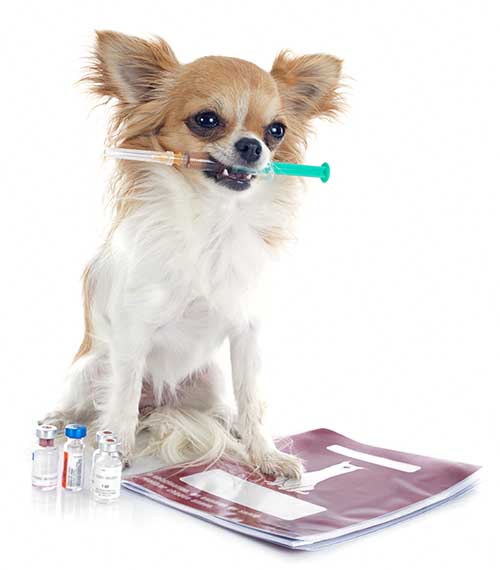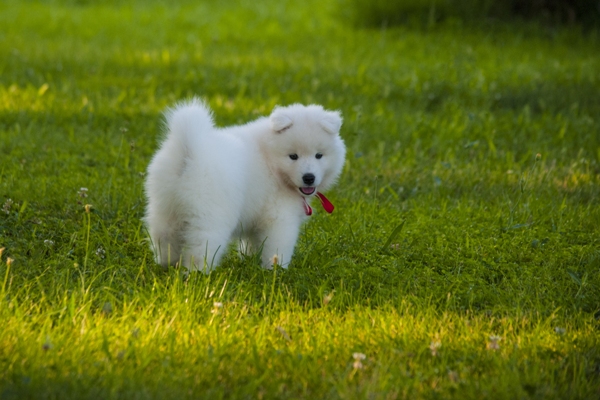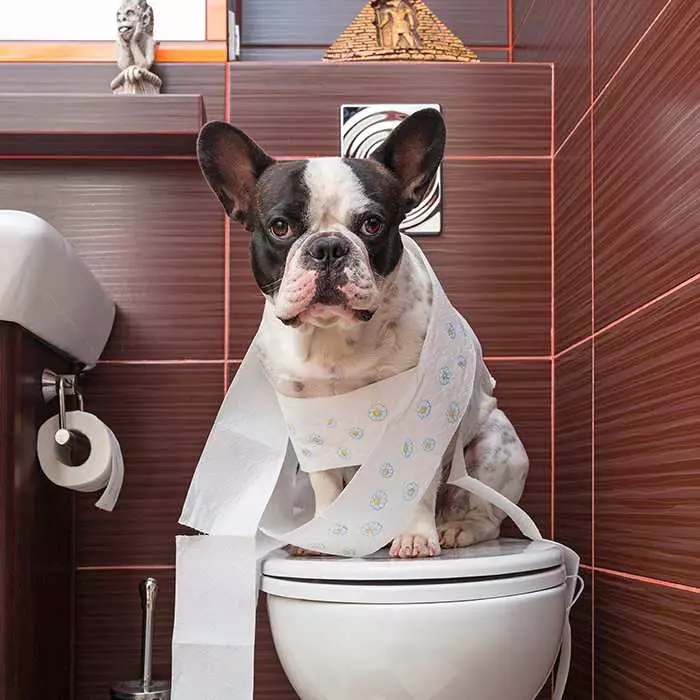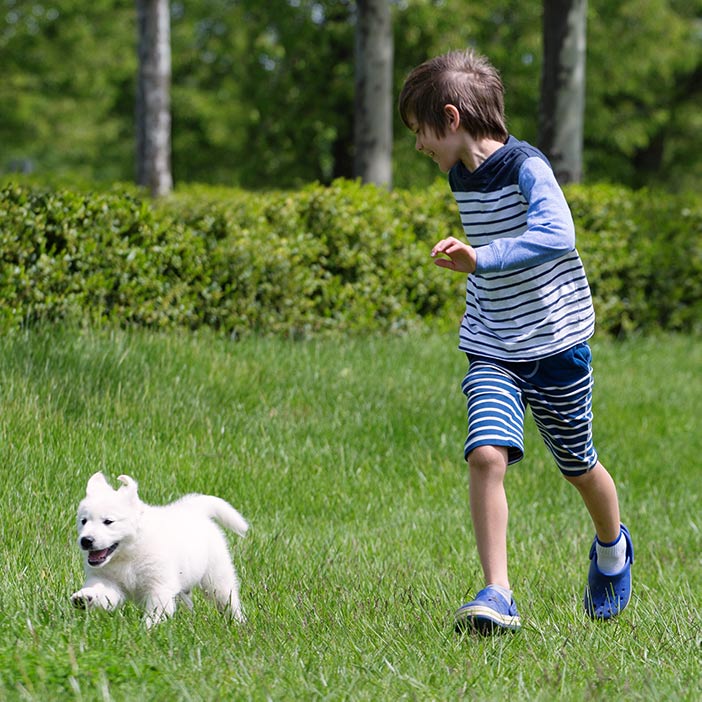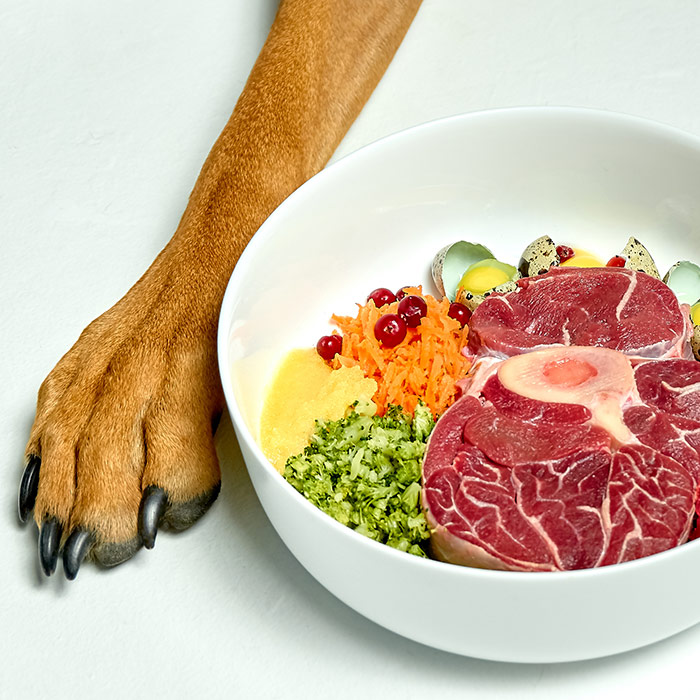Dietary requirements of adolescent dogs
Adolescence in dogs is the transitional phase between puppyhood and adulthood. Puppies mature very quickly, and within a matter of months your cuddly baby has become a gawky adolescent. He now looks more like an adult dog; he is close to reaching his adult height and is beginning to fill out and put on some muscle. He now has his full set of adult teeth. His bones are still growing, but not nearly as fast as they did when he was three or four months old.
The smaller his breed, the faster the dog reaches adolescence:
- In toy and small breeds, adolescence can start as early as 5 months
- In larger breeds it can start as late as 9 or 10 months
- In very large breeds adolescence may not begin until 12 to 18 months
The duration of adolescence also depends on breed size, lasting anywhere from a few months in small breeds to up to a year in giant breeds. By the end of this stage, dogs have reached their adult body weight and height.

Adolescence, hormones and weight
Biologically speaking, adolescence begins when a puppy reaches puberty – the process by which juveniles become behaviourally and reproductively mature. It is a period of significant hormonal changes and is marked by attainment of sexual maturity, which usually occurs between eight and 12 months.
During adolescence, intact dogs undergo a surge in the production of sex hormones. An intact female adolescent will come into season for the first time, usually in the second half of her first year (commonly between 6 and 9 months). Intact male adolescents begin producing high levels of testosterone and they start to show an interest in females and to exhibit sexual behaviours.
Neutering: a nutritional milestone
Many dogs are neutered or spayed prior to or during adolescence; females are often neutered once their first season is complete. Neutering inhibits the production of sex hormones, which results in a decreased metabolic rate and lower energy requirements. As a result of the change in hormone levels within their bodies, neutered dogs often put on weight.
In order to stay at a healthy weight and body condition, neutered dogs must have some change made to either the amount or type of food they are fed. Current thinking is that spayed or neutered dogs need about 30- 40% fewer calories than intact dogs. The American Kennel Club (AKC) recommends switching from puppy food to adult food following the procedure. Unfortunately, many dog owners do not make this adjustment; most neutered pets are overfed and under-exercised and are twice as likely to become obese.
Recommended feeding schedule by age
During puppyhood, it’s essential that the fast-growing pup’s diet provides an adequate supply of nutrients to meet his high energy requirements. A young puppy can double his weight each month and requires almost twice the calories as an adult dog of the same weight. He needs specially formulated puppy food – known as a ‘growth diet’ – and multiple daily feeds to promote optimal growth.
 As puppies grow into adolescents, their metabolism decreases, and their growth rate slows down. If they continue to eat the same amount, they are very likely to become overweight. Unless they are very active, the amount of food adolescent dogs requires is less than the amount they needed as younger pups.
As puppies grow into adolescents, their metabolism decreases, and their growth rate slows down. If they continue to eat the same amount, they are very likely to become overweight. Unless they are very active, the amount of food adolescent dogs requires is less than the amount they needed as younger pups.
The number of daily feedings can be gradually decreased as the puppy ages, generally from 4 feeds in early puppyhood, to 3 feeds from 3 to 6 months, to two feeds per day from around 6 months (note that there is some variation depending on breed size and age for pre-adolescent puppies). The general recommendation is 2 meals per day during adolescence, regardless of breed size.
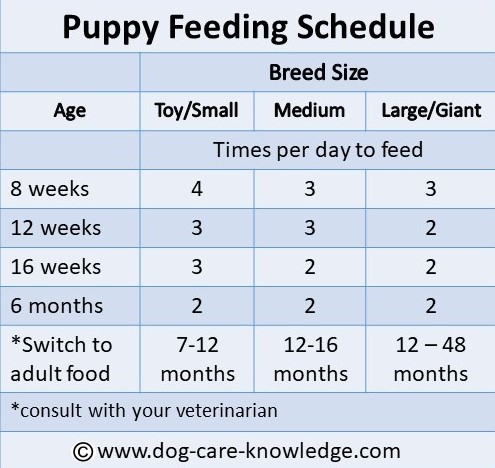
How much should an adolescent dog eat?
Just as important as feeding frequency is meal portion size. As your puppy grows, the amount he is fed will need to be adjusted along with the number of meals he has each day, but many owners often don’t adjust the quantity of food when their pup becomes adolescent. However, there is no one-size-fits-all portion size; the amount that your adolescent dog requires per portion will depend on his size, breed, age, health and level of exercise.
Commercial dog foods have guides on the packaging that recommend how much a dog of a particular age and weight should generally be eating. These quantities are an estimate that are usually aimed at the average dog; however, dogs can differ significantly in their size, activity level and the environment in which they live. While the packaging guide can provide a starting point, be aware that the suggested quantity may not be the ideal amount for your dog’s requirements.
Body condition
Overfeeding or underfeeding your adolescent dog can both have detrimental consequences. According to the Australian Veterinary Association, the best way to tell if you are feeding the right amount is to assess your dog’s body condition every couple of weeks and adjust the feeding amount as necessary. You can assess his body condition in three quick and easy steps:
- Run your hands along your puppy’s sides – a healthy body condition is one where you can easily feel, but not see, the ribs.
- Look down at your puppy from above – he should have an obvious waistline.
- Look at your puppy side on – you should see an abdominal tuck.
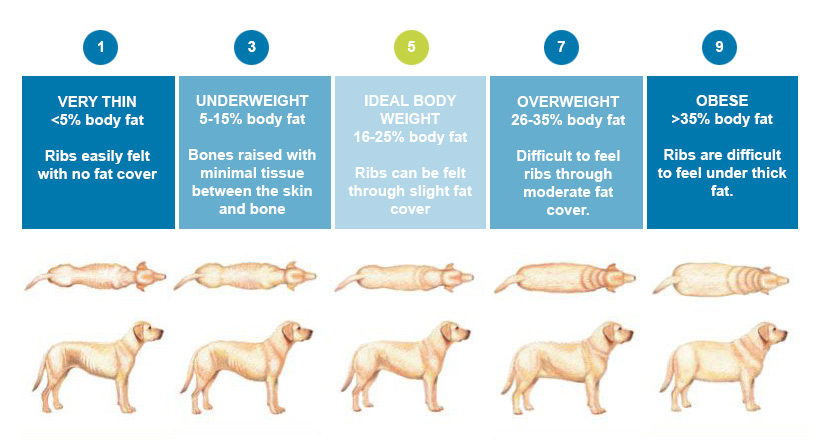
Source: http://homeforgooddogs.org/wp-content/uploads/2020/05/Fat-Guide.jpg
Obesity in dogs is a very real problem in Australia nowadays. Obesity can lead to diabetes, diseases of the heart and other organs, and general lethargy. Research indicates that overfeeding puppies, particularly large and giant breeds, can predispose them to muscle and bone problems, as well as obesity. A young dog carrying too much weight has an increased risk of orthopaedic problems because of stress on immature joints. In large breeds and breeds that are prone to obesity, portion control is essential to ensure a slow rate of weight gain and a healthy body condition to avoid joint and skeletal problems that have been associated with a fast rate of growth.
If you are concerned about your adolescent dog’s body condition and/or weight, a consultation with your veterinarian can provide guidance and reassurance. Your vet will weigh your dog, assess his body condition score and help you determine the best feeding schedule and quantity of food for his needs. Vets are trained in animal nutrition and can ensure that your dog is eating a balanced diet and/or recommend alternative or more suitable feeding options.
Top tips for large breed adolescents:
- Don’t leave food in your puppy’s bowl all day (free feeding), because this is a sure way for him to overeat.
- Avoid feeding him table scraps and/or human snacks.
- Rather feed him two smaller meals a day than one large one, which can contribute to a serious condition called bloat.
- As your large puppy grows larger, beware of leaving food out on the table or kitchen counter, as before long he will be able to help himself!
What should you feed your adolescent dog?
Dogs require specific dietary nutrient concentrations based on their life stage in order to maintain an ideal body weight and to ensure optimal health. There are also differences between the nutritional needs of small-breed and large-breed dogs, especially for puppies and adolescents.
During adolescence, a high quality, balanced, premium, nutrient-dense puppy diet should remain the primary source of food until the end of adolescence (or earlier for neutered dogs; see above). Nutritionally, adolescents still require higher levels of bone-growing nutrients like calcium and phosphorous, as well as brain developing nutrients like DHA, an essential Omega 3 fatty acid. Switching to adult food too early may deprive your adolescent of these important nutrients.
The bulk of a complete and balanced adolescent-puppy diet can be comprised of wet or dry commercial products or a combination of both. To provide variety, you can add other elements to the diet such as fresh meat and occasional raw, meaty bones. To ensure food safety, choose cheaper cuts of human-grade meat and avoid processed meats containing preservatives.
Research indicates that 70% of overweight puppies grow up to be overweight adults. To prevent your adolescent from becoming overweight whilst still providing the nutrients he requires, the AVA suggests looking for a young-adult-specific food or developing a mix of puppy and adult food to keep essential nutrients available while restricting the total calories as your dog gets older.
Which brand is best?
There are no laws governing pet food manufacturing in Australia, rather a voluntary standard which outlines requirements for production, food safety, nutrition and labelling. Unfortunately, this means that buying pet food can be mine-field that could potentially put your dog’s health at risk.
Vets are trained in animal nutrition. The best thing you can do for your dog is buy a reputable brand that is recommended by your vet for your specific animal. Factors that can affect the vet’s choice include breed and size, age, neutering status (spayed or intact) and any underlying health conditions. Veterinary practices often sell specific premium and speciality brands of pet foods, and although these can be expensive, they are usually based on extensive scientific research and comprise quality ingredients. Often these brands are also available online at a lower price.
When purchasing a brand from a pet store or supermarket, always read the label before purchasing a new product and check your usual ones periodically for any changes. The most important things to look for on the label when selecting dog food:
- A statement that the food is ‘complete’ and ‘balanced’, meaning it contains the correct ratio of protein, fats, carbohydrates, vitamins and minerals.
- Compliance with the Australian Standard for the Manufacturing and Marketing of Pet Food AS5812:2017.
- A nutritional guarantee that it meets the recommended nutritive requirements outlined by AAFCO (Association of American Feed Control Officials) in the US or FEDIAF in Europe.
- A statement that it is appropriate for the dog’s life stage (puppy, adolescent, adult, pregnant, senior) and health status.
- An ingredients list (all ingredients except for water should be arranged in descending order of the proportion by weight of the ingredient contained in the food).
- A nutritional information panel listing the percentage of protein, fat and energy/calories at a minimum.
- Directions for use, including a daily feeding guide.

Source: https://pfiaa.com.au/wp-content/uploads/2020/02/Pet-Food-Label-page-001-1170×827.jpg
When should you switch to adult food?
Feeding with a high-quality puppy diet should continue until the start of adulthood or when your adolescent reaches approximately 90% of his expected adult weight. This milestone is usually reached at around 9 to 12 months in small to medium breeds and from 15 to 24 months in large to giant breeds. An exception is if a dog is neutered during adolescence, then the AKC recommends switching from puppy food to adult food after the procedure.
An adult “maintenance” diet contains fewer calories and nutrients than a puppy “growth” diet. An adult diet is introduced towards the end of adolescence because the rate of growth has slowed considerably, and young adult dogs therefore need fewer calories. If the dog continues eating a puppy diet past this point, you run the risk of creating an overweight dog. If you switch to an adult diet too soon, however, you may inadvertently deprive the dog of essential nutrients necessary for healthy skeletal and brain development. Therefore, the AKC recommends erring on the side of caution, emphasising that it’s better to be on puppy food a little too long than not long enough.
How to switch to adult food
The general recommendation when switching from puppy food to adult food is to perform a gradual transition over approximately 7 days (or even longer in dogs with health conditions or prone to tummy upsets). The different foods can be mixed in the same feeding bowl. Sudden changes should be avoided because they can result in vomiting and diarrhoea.
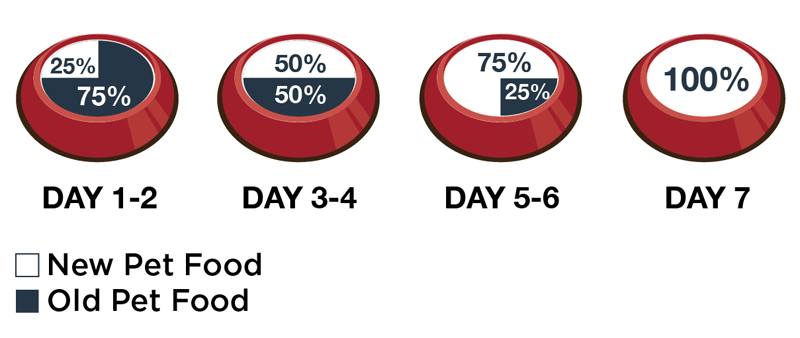
Source: https://3fj1k71jn8q63mwg4a1736w9-wpengine.netdna-ssl.com/wp-content/uploads/2017/03/blog_0317_02.gif
Summary
- Adolescent dogs have different nutritional requirements from puppies and adult dogs, in terms of both the quantity and type of food.
- Other important factors to consider include breed size, activity levels, general health and neutering status.
- There are serious health consequences to overfeeding and underfeeding your adolescent dog.
- Your veterinarian is your best resource for information regarding your particular dog’s health and nutrition requirements.
- Always select a high-quality product suitable for the dog’s age and size, that is marked as ‘complete’ and ‘balanced’, and that complies with the Australian Standard.
Learn more
- https://www.vetvoice.com.au/articles/feeding-your-puppy–a-guide-for-the-first-12-months/
- https://kb.rspca.org.au/knowledge-base/what-should-i-feed-my-puppy/
- https://www.choice.com.au/outdoor/pets/products/buying-guides/pet-food
- https://pfiaa.com.au/your-pet-food/
Bow Wow Meow Pet Insurance can help protect you and your dog should an unexpected trip to the vet occur.
-
Find out more about our dog insurance options
-
Get an online pet insurance quote
Bow Wow Meow is proud to have been awarded winner of Canstar’s ‘Most Satisfied Customers’ Award in the Pet Insurance category for both 2024 and 2025!
Bow Wow Meow is proud to have been chosen as Product Review’s Pet Insurance Award Winner every year from 2018 to 2025! This is based on 2,995 independent customer reviews (as at 21/01/2025), with an overall rating of 4.3*
Google Review rating = 4.5* (based on 968 reviews)
Trust Pilot rating = 4.6* (based on 531 reviews)
Bow Wow Meow is proud to have been chosen as Product Review’s Pet Insurance Award Winner every year from 2018 to 2025! This is based on 2,995 independent customer reviews (as at 21/01/2025), with an overall rating of 4.3*
Google Review rating = 4.5* (based on 968 reviews)
Trust Pilot rating = 4.6* (based on 531 reviews)
Bow Wow Meow has been chosen as a winner in the Finder Pet Insurance Awards 2024. Finder’s panel of experts analysed over 140 quotes to award our Ultimate Care Plan the winner of the “Pet Insurance – Value” category.




